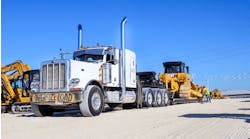A number of questions related to tire evaluation, selection, and maintenance pop up repeatedly over the years, partly because the answers are more complicated than many of us realize. One of the problems is the number of variables that can impact these basic tire issues, which makes coming up with a straightforward answer a sometimes murky proposition. Here's my attempt to add some clarity to the situation.
One excellent example is how to properly adjust “recommended inflation pressure” for temperature variations. We know that there is a relationship among pressure, temperature, and volume that demands a change in one or two of the other variables if temperature is changed. We also know that tire temperatures rise when they're moving, compared to when they're at rest, or “cold.” These temperature and pressure increases are normal; they're part of the tire design, provided load and inflation conditions are within the limits specified by the tire manufacturer and/or an industry group such as The Tire and Rim Assn.
It's normal for tires with a cold inflation of 100 psi to stabilize at 110 or even 120 psi when running in high-speed highway service. So tire inflation pressures should always be checked when the tires are cold, i.e., at least two hours after the truck has come to rest. If the pressure is above the cold spec, it's not necessary to bleed it down unless it's excessive, i.e., over by 20 psi or more.
Some seasonal variation does occur, and all modern radial tires lose slight amounts of their high-pressure inflation over time due to normal diffusion. That's why it's so important to do periodic pressure checks.
People often ask whether cold inflation pressures are season- or location-specific, e.g., summer vs. winter or Florida vs. Maine. The short answer is “no,” because industry load/inflation tables are based on local ambient temperatures. Experience has shown that the temperature and pressure buildup created by normal highway speeds tends to remain the same within the range of all but very extreme ambient conditions. So you should follow the recommended cold inflation recommendations, regardless of your zip code.
Another cloudy issue is rolling resistance, which impacts fuel economy. The Technology and Maintenance Council (TMC) and the Society of Automotive Engineers (SAE) have published detailed fuel-economy test procedures that are designed to identify legitimate fuel consumption differences between test runs of new equipment — including tires and other devices — compared to a reference or baseline. Such evaluations can be difficult since we're looking at very small differences. It's really the equivalent of looking for a spike, if not a needle, in a haystack.
There are, however, some generic tire characteristics to keep in mind. First, shallow tread tires, i.e., those worn to near normal takeoff, deliver significantly better fuel economy than new tires. In fact, it's common to find a 6% difference in fuel economy if you compare deep-tread dual mounted drive tires that are new with those that are worn. Moreover, since steer, drive, and trailer axle tires are usually replaced at different mileage intervals, the overall fuel economy of the truck is affected by the total tire combination. You must take into account where in its lifecycle each tire happens to be.
GVW loading differences can also affect fuel economy. In fact, for every 10,000-lb. difference in GVW, fuel economy can change by 5%.
These two often-overlooked variables can affect fuel economy far, far more than differences in other factors that are commonly used to justify some equipment brand, model, or maintenance-practice decisions.


